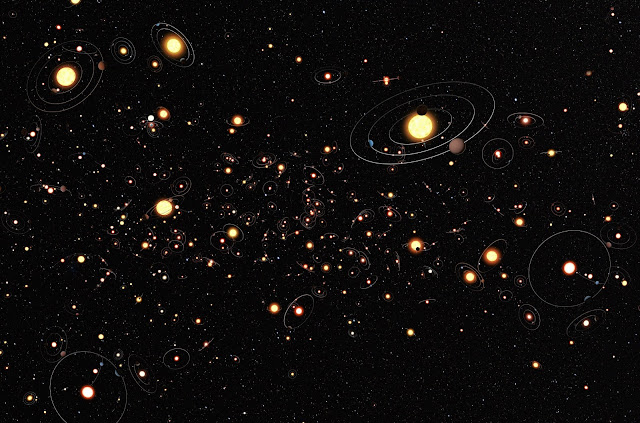This artist's illustration gives an impression of how common planets are around the stars in the Milky Way. The planets, their orbits, and their host stars are all vastly magnified compared to their real separations. A six-year search that surveyed millions of stars using the microlensing technique concluded that planets around stars are the rule rather than the exception. The average number of planets per star is greater than one.
An international team, including three astronomers from the European Southern Observatory (ESO), has used the technique of gravitational microlensing to measure how common planets are in the Milky Way. After a six-year search that surveyed millions of stars, the team concludes that planets around stars are the rule rather than the exception. The results will appear in the journal Nature on 12 January 2012.
Over the past 16 years, astronomers have detected more than 700 confirmed exoplanets and have started to probe the spectra and atmospheres of these worlds. While studying the properties of individual exoplanets is undeniably valuable, a much more basic question remains: how commonplace are planets in the Milky Way?
Most currently known exoplanets were found either by detecting the effect of the gravitational pull of the planet on its host star or by catching the planet as it passes in front of its star and slightly dims it. Both of these techniques are much more sensitive to planets that are either massive or close to their stars, or both, and many planets will be missed.
An international team of astronomers has searched for exoplanets using a totally different method — gravitational microlensing — that can detect planets over a wide range of mass and those that lie much further from their stars.
Arnaud Cassan (Institut dʼAstrophysique de Paris), lead author of the Nature paper, explains: "We have searched for evidence for exoplanets in six years of microlensing observations. Remarkably, these data show that planets are more common than stars in our galaxy. We also found that lighter planets, such as super-Earths or cool Neptunes, must be more common than heavier ones."
The astronomers used observations, supplied by the PLANET and OGLE teams, in which exoplanets are detected by the way that the gravitational field of their host stars, combined with that of possible planets, acts like a lens, magnifying the light of a background star. If the star that acts as a lens has a planet in orbit around it, the planet can make a detectable contribution to the brightening effect on the background star.
Jean-Philippe Beaulieu (Institut d'Astrophysique de Paris), leader of the PLANET collaboration adds: "The PLANET collaboration was established to follow up promising microlensing events with a round-the-world network of telescopes located in the southern hemisphere, from Australia and South Africa to Chile. ESO telescopes contributed greatly to these surveys.”
Microlensing is a very powerful tool, with the potential to detect exoplanets that could never be found any other way. But a very rare chance alignment of a background and lensing star is required for a microlensing event to be seen at all. And, to spot a planet during an event, an additional chance alignment of the planet’s orbit is also needed.
Although for these reasons finding a planet by microlensing is far from an easy task, in the six year's worth of microlensing data used in the analysis, three exoplanets were actually detected in the PLANET and OGLE searches: a super-Earth , and planets with masses comparable to Neptune and Jupiter. By microlensing standards, this is an impressive haul. In detecting three planets, either the astronomers were incredibly lucky and had hit the jackpot despite huge odds against them, or planets are so abundant in the Milky Way that it was almost inevitable .
The astronomers then combined information about the three positive exoplanet detections with seven additional detections from earlier work, as well as the huge numbers of non-detections in the six year's worth of data — non-detections are just as important for the statistical analysis and are much more numerous. The conclusion was that one in six of the stars studied hosts a planet of similar mass to Jupiter, half have Neptune-mass planets and two thirds have super-Earths. The survey was sensitive to planets between 75 million kilometres and 1.5 billion kilometres from their stars (in the Solar System this range would include all the planets from Venus to Saturn) and with masses ranging from five times the Earth up to ten times Jupiter.
Combining the results suggests strongly that the average number of planets around a star is greater than one. They are the rule rather than the exception.
“We used to think that the Earth might be unique in our galaxy. But now it seems that there are literally billions of planets with masses similar to Earth orbiting stars in the Milky Way,” concludes Daniel Kubas, co-lead author of the paper.
Image Credit: NASA, ESA, and M. Kornmesser (ESO)
Explanation from: http://hubblesite.org/newscenter/archive/releases/2012/07/image/a/ and https://www.eso.org/public/news/eso1204/




No comments:
Add your comment